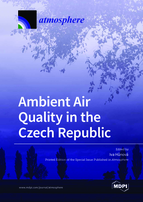Ambient Air Quality in the Czech Republic
A special issue of Atmosphere (ISSN 2073-4433). This special issue belongs to the section "Air Quality".
Deadline for manuscript submissions: closed (30 March 2020) | Viewed by 61934
Special Issue Editor
Interests: atmosphere; ambient air quality; atmospheric deposition; ground-level ozone; long-term trends and spatial patterns; air pollution assessment
Special Issues, Collections and Topics in MDPI journals
Special Issue Information
Dear Colleagues,
The Czech Republic (CR) is a Central European country with an infamous environmental pollution history and long-term problems due to heavy air pollution in the past. These were mostly due to emissions from burning poor-quality lignite of local provenience with very high contents of sulphur, used both for coal-powered thermal power plants and for local, domestic heating systems. Extremely high SO2 emissions adversely affected the health of the inhabitants and resulted in serious environmental damages, including spruce forest decline. Furthermore, emissions from high stacks of large power plants substantially contributed to pollution due to their long-range transport, causing acid rain and acidification of ecosystems in other European regions, such as Scandinavia. The infamous “Black Triangle”, a border region situated between former Czechoslovakia, East Germany, and Poland, was one of the most polluted areas of Europe at that time.
As a consequence of fundamental socioeconomic changes triggered by the so-called “Velvet Revolution” in 1989, including the introduction of a new legislation, the application of effective countermeasures in emission reduction, and the modernization of energy production and industry alongside with the extensive gasification of local heating systems, the overall situation in ambient air quality has improved substantially. An unprecedented reduction in SO2 emissions by about 90% has been recorded, accompanied by reductions in TSP (total suspended particles) and NOx. Nevertheless, new challenges have emerged in air pollution control, such as the presence of fine aerosol particles, ground-level ozone, benzo(a)pyrene, and various pollutants whose ambient air concentration currently extensively exceeds the legal limit values and is very difficult to manage, affecting a substantial part of the population and vast regions.
Atmosphere is hosting a Special Issue to showcase the changes in ambient air quality in the Czech Republic. I invite you to contribute articles to this Special Issue by reporting on observation-based and modelling studies related to the past and present ambient air quality in the Czech Republic. Solicited contributions include but are not limited to studies on long-term trends in ambient air pollutants and atmospheric deposition, emissions, and emission sources, transboundary, long-range, and regional-range transport of air pollutants, and behaviour of atmospheric pollutants in particular in the context of the on-going climate change. Articles on the impact of ambient air pollution on human health and environment, including vegetation and ecosystems in the Czech Republic, are also encouraged.
Dr. Iva Hůnová
Guest Editor
Manuscript Submission Information
Manuscripts should be submitted online at www.mdpi.com by registering and logging in to this website. Once you are registered, click here to go to the submission form. Manuscripts can be submitted until the deadline. All submissions that pass pre-check are peer-reviewed. Accepted papers will be published continuously in the journal (as soon as accepted) and will be listed together on the special issue website. Research articles, review articles as well as short communications are invited. For planned papers, a title and short abstract (about 100 words) can be sent to the Editorial Office for announcement on this website.
Submitted manuscripts should not have been published previously, nor be under consideration for publication elsewhere (except conference proceedings papers). All manuscripts are thoroughly refereed through a single-blind peer-review process. A guide for authors and other relevant information for submission of manuscripts is available on the Instructions for Authors page. Atmosphere is an international peer-reviewed open access monthly journal published by MDPI.
Please visit the Instructions for Authors page before submitting a manuscript. The Article Processing Charge (APC) for publication in this open access journal is 2400 CHF (Swiss Francs). Submitted papers should be well formatted and use good English. Authors may use MDPI's English editing service prior to publication or during author revisions.
Keywords
- Air pollution
- Long-term trends
- Spatial patterns
- Impacts on health
- Impacts on environment






